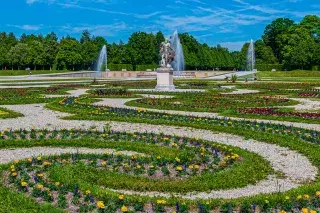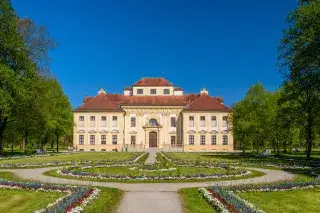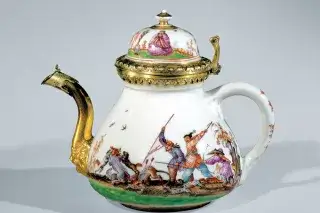Summer palace with porcelain museum in Oberschleißheim
Lustheim Palace in the Schleißheim palace complex near Munich
Lustheim Palace was often the scene of exuberant festivities during the time of the monarchy. See what you can discover here today.

More actions
Lustheim Palace at a glance
- The palace complex in Oberschleißheim north of Munich comprises a total of three palaces and an extensive garden. It can be reached quickly by S-Bahn S1 from Munich and is perfect for a day trip.
- Lustheim Palace was built in June 1685 on the occasion of the marriage of the young Elector Max Emanuel to an Austrian emperor's daughter. As the name suggests, it served purely as a pleasure and hunting palace and was not permanently inhabited.
- Today, a valuable collection of early Meissen porcelain is on display there.
Tip: Stroll through the courtyard garden to the hunting mansion

More than a kilometer away from the New Palace, Lustheim Palace is the "point de vue" of the baroque gardens of the Schleißheim palace complex.
Passing broderies and hedges, the water areas, the fountains and the cascade, along the central canal, a short walk leads to the small pleasure and hunting mansion.
Pavilions, banquet hall, ceiling frescoes: architecture of the Lustheim Palace

A small hall at the very top above the roof of the central section crowns the ornate palace. Elector Max Emanuel enjoyed the expansive view from there. Inside, a banquet hall extends over two floors, to the side of which were the apartments of the elector and electress with colorful ceiling frescoes.
Two pavilions outside the ring canal complete the unit. The Southern Pavilion with the Renatus Chapel has an oval room with an altar set in gold and a valuable ceiling fresco.
The Meissen Porcelain Collection

Since 1971, Lustheim Palace has housed the collection of early Meissen porcelain donated by the industrialist Prof. Dr. Ernst Schneider. With over 2,000 pieces, it is comparable in size and importance only to the holdings in the Dresden Zwinger.
The collection offers a comprehensive overview of the production of the Meissen porcelain manufactory from its foundation in 1710 to the time of the Seven Years' War (1756-1763): from tableware and figurines of the Böttger period, famous chinoiseries by Johann Gregorius Höroldt, native American decors to sculptural masterpieces by the modeller Johann Joachim Kaendler.
Directions and parking. How to get to Oberschleißheim
- Public transport: S-Bahn S1 to "Oberschleißheim", then it's a 10 to 15 minute walk or take the bus to the "Schloss" stop.
- By car: Oberschleißheim can be reached via the Autobahn A92 (exit Oberschleißheim), A99 (exit Neuherberg), as well as the federal roads B13 and B471.
- Parking situation: There are about 120 parking spaces for cars at the New Palace. Parking is also available here for buses.
Destinations near Schleißheim Palace complex
- There are other palaces to discover on the Schleißheim palace complex. A special attraction are also the gondola rides on the palace canal in summer.
- Helicopters, military aircraft and many other aerospace exhibits await you at Flugwerft Schleißheim (German page).
- The nearby Feringasee is the largest bathing lake in the immediate vicinity of Munich.
History: Lustheim Palace as a venue for lavish celebrations
The reason for building this pleasure palace was a romantic one: on the occasion of his marriage to the Austrian emperor's daughter Maria Antonia in June 1685, the Bavarian elector Max Emanuel commissioned his court architect Henrico Zuccalli to build the Lustheim palace.
Placed at a distance of about 1300 meters from the (Old) Palace in its central axis, Lustheim was to form the center of its own garden complex. As the name suggests, it served purely as a pleasure and hunting lodge and was not permanently inhabited. Lustheim is considered an ideal example of an Italian casino, with a large ballroom and adjoining apartments for the electoral couple.
At a glance
Lustheim Palace
Max-Emanuel-Platz
1
85764
Oberschleißheim
Tel:
49893158720


